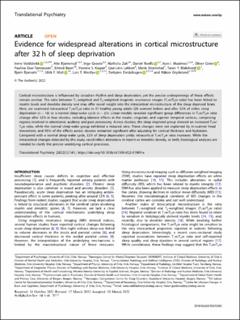| dc.contributor.author | Voldsbekk, Irene | |
| dc.contributor.author | Bjørnerud, Atle | |
| dc.contributor.author | Groote, Inge Rasmus | |
| dc.contributor.author | Zak, Nathalia | |
| dc.contributor.author | Roelfs, Daniël | |
| dc.contributor.author | Maximov, Ivan | |
| dc.contributor.author | Geier, Oliver | |
| dc.contributor.author | Due-Tønnessen, Paulina | |
| dc.contributor.author | Bøen, Erlend | |
| dc.contributor.author | Kuiper, Yvonne S. | |
| dc.contributor.author | Løkken, Lise Linn | |
| dc.contributor.author | Strømstad, Marie | |
| dc.contributor.author | Blakstvedt, Taran Youssefian | |
| dc.contributor.author | Bjorvatn, Bjørn | |
| dc.contributor.author | Malt, Ulrik Fredrik | |
| dc.contributor.author | Westlye, Lars Tjelta | |
| dc.contributor.author | Elvsåshagen, Torbjørn | |
| dc.contributor.author | Grydeland, Håkon | |
| dc.date.accessioned | 2022-07-13T12:01:15Z | |
| dc.date.available | 2022-07-13T12:01:15Z | |
| dc.date.created | 2022-04-19T13:30:48Z | |
| dc.date.issued | 2022 | |
| dc.identifier.issn | 2158-3188 | |
| dc.identifier.uri | https://hdl.handle.net/11250/3005046 | |
| dc.description.abstract | Cortical microstructure is influenced by circadian rhythm and sleep deprivation, yet the precise underpinnings of these effects remain unclear. The ratio between T1-weighted and T2-weighted magnetic resonance images (T1w/T2w ratio) has been linked to myelin levels and dendrite density and may offer novel insight into the intracortical microstructure of the sleep deprived brain. Here, we examined intracortical T1w/T2w ratio in 41 healthy young adults (26 women) before and after 32 h of either sleep deprivation (n = 18) or a normal sleep-wake cycle (n = 23). Linear models revealed significant group differences in T1w/T2w ratio change after 32 h in four clusters, including bilateral effects in the insular, cingulate, and superior temporal cortices, comprising regions involved in attentional, auditory and pain processing. Across clusters, the sleep deprived group showed an increased T1w/T2w ratio, while the normal sleep-wake group exhibited a reduced ratio. These changes were not explained by in-scanner head movement, and 95% of the effects across clusters remained significant after adjusting for cortical thickness and hydration. Compared with a normal sleep-wake cycle, 32 h of sleep deprivation yields intracortical T1w/T2w ratio increases. While the intracortical changes detected by this study could reflect alterations in myelin or dendritic density, or both, histological analyses are needed to clarify the precise underlying cortical processes. | en_US |
| dc.language.iso | eng | en_US |
| dc.publisher | Nature Research | en_US |
| dc.rights | Navngivelse 4.0 Internasjonal | * |
| dc.rights.uri | http://creativecommons.org/licenses/by/4.0/deed.no | * |
| dc.title | Evidence for widespread alterations in cortical microstructure after 32 h of sleep deprivation | en_US |
| dc.type | Journal article | en_US |
| dc.type | Peer reviewed | en_US |
| dc.description.version | publishedVersion | en_US |
| dc.rights.holder | Copyright The Author(s) 2022 | en_US |
| dc.source.articlenumber | 161 | en_US |
| cristin.ispublished | true | |
| cristin.fulltext | original | |
| cristin.qualitycode | 1 | |
| dc.identifier.doi | 10.1038/s41398-022-01909-x | |
| dc.identifier.cristin | 2017573 | |
| dc.source.journal | Translational Psychiatry | en_US |
| dc.identifier.citation | Translational Psychiatry. 2022, 12, 161. | en_US |
| dc.source.volume | 12 | en_US |

